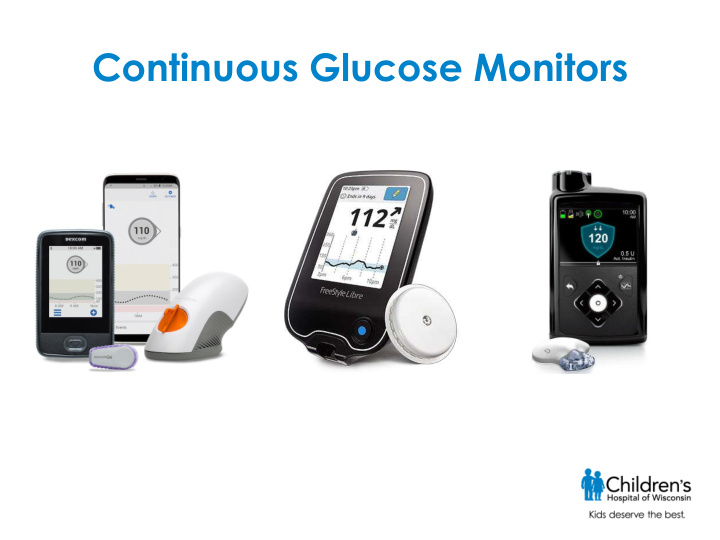



Continuous Glucose Monitors
What is CGM? • Continuous Glucose Monitoring systems use a tiny sensor inserted under the skin to check glucose levels in tissue fluid. • Sensor replaced every 7-10 days • A reusable transmitter sends information about glucose levels via radio waves from the sensor to a wireless device • The information may go to a phone, receiver or insulin pump
How CGM works • A tiny electrode (sensor) is inserted just under the skin – Sensor is replaced every 7-10 days • A reusable transmitter is attached to the sensor – Transmitter is reused and replaced when needed • Sensor continually measures glucose levels in the interstitial fluid (IF) – There is a lag time between when glucose hits blood and the fluid • Transmitter locks into the sensor – Sends data via blue tooth to a receiver or smart device – Sensor glucose reading is shown on a screen • Includes directional arrows and a graph
Parts of CGM 1. Sensor 2. Transmitter 3. Receiver
Advantages • Can provide real time glucose information every 5 minutes – Up to 288 readings in a 24 hour period • Shows where glucose is – Current number on machine • Shows where glucose was – Trend graph • Predicts where glucose is going – Rate of change arrows • Certain devices are FDA approved to use for dosing • Remote monitoring • Multiple alarm settings • Reduced or eliminates finger-sticks
Blood Glucose Data Vs. CGM Data
Dexcom Available Models: G5, G6 Similarities: • Remote Monitoring-If the student has a blue- tooth enabled device near them, the results can be remotely monitored. • Set high and low alarms • Shows glucose trending arrows • Updates glucose reading every five minutes • May be covered by state health insurance
Dexcom Comparison Dexcom G5 Dexcom G6 - CAN NOT be used to dose from unless - CAN be used to determine insulin dose you are sure it is being calibrated twice -Does not require calibrations per day. - CAN be used with acetaminophen - Requires Calibrations -Can NOT be used with acetaminophen -Larger size -Smaller size -Set high and low alarm -Predictive low alarm in addition to high -7-day wear and low alarms -10-day wear
Libre Flash • Quarter-sized sensor that will give glucose value when the reader is swiped over the top. • Shows trending arrows • CAN be used to determine dosing • Not covered by state health insurance • Can be used with phone app for sensor glucose readings
Medtronic Pump • Enlite or Guarian 3 Sensors used with Medtronic pumps • NOT used for dosing • Shows trending arrows • Set high and low alarms
CGM Accuracy MARD: Mean Absolute Relative Difference between the blood glucose monitoring system value and the lab reference value. (The lower the better) • The glucometer and CGM can have different values and still fall within a range that is considered accurate CGMs MARD Dexcom 9% Libre 11.4% Most Glucometers are around 15%
CHW Recommendations for Use in School Setting • The student may need to have cell phone with them or use school Wi-Fi to transmit data to remote receivers during the school day. • Constant monitoring by school personnel is not expected, priority should be given to low and high alerts. • High alerts may occur after eating and will not always need to be treated. There must be two hours between insulin doses. • Blood glucose should be checked with finger poke if symptoms don’t match the sensor glucose reading or if the trending arrows are double arrows up.
Recommend
More recommend